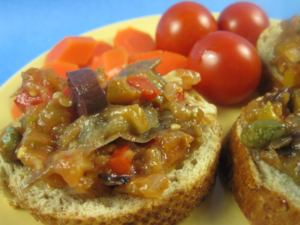 by Pat Eby
by Pat Eby
Here’s the romance. Sometimes my job is fun. For a recent story I sampled craft cocktails on an early fall evening in a Victorian-era park with the live sounds of a New Orleans-style brass band in the background. Doesn’t that sound great? It is, but here’s the reality—it’s work.
For professional food writers an assignment begins well before the first sip or bite, with research on foods, farmers, restaurants, chefs, or products. It doesn’t end with a simple story well told. We take photos to help tell the tale. We provide well-written and tested recipes to run with the story.
Just as each publication has a style guide for writers, food sections have additional guides for recipes. The procedure I follow gives the recipe yield or number of servings under the title, lists ingredients in detailed quantities, in the order of use, and provides a step-by-step preparation method.
Recipes must be written accurately and tested with precision. People spend good money on ingredients and take time to cook the lovely things we write about. Recipes must be complete and understandable. Editors love it when they get kudos for wonderful dishes instead of brickbats over disastrous dinners.
I like food writer Sara Kate Gillingham’s overview of what works in recipe writing for most publications. http://www.thekitchn.com/how-to-write-a-recipe-58522
The rewards of food writing well done aren’t what most people think. I don’t eat and drink for free. I’m paid to do my work. I pay my way with farmers, caterers, restaurant owners, and food retailers. The Association of Food Journalists provides a detailed code of ethics and a separate document for food critics. Responsibilities come with food writing. http://www.afjonline.com/ethics.cfm http://www.afjonline.com/FoodCriticsGuidelines.cfm
As a professional food writer, my rewards come in e-mails from people who tried a dish and loved it, from restaurant owners who tell me I “got” their story, and in the thanks from farmers, God bless them, who aren’t often recognized for what they do every day in the fields.
I love my job. Food is an important part of our everyday lives. We nourish ourselves not only in body, but also in spirit when we eat with family and friends. We build community through shared tables. Food is essential. Writing about food rarely feels trivial. The future of food writing, however, is a bit unclear.
Amanda Hesser, CEO and founder of the incredible food blog Food52, wrote a sobering column in 2012, Advice for Future Food Writers. It’s invaluable and instructive. http://food52.com/blog/3195-advice-for-future-food-writers
Hesser sketches a gritty future when publications flounder, jobs disappear, and stories pay less per word and per piece. At first it discouraged me, but in subsequent reads I was inspired to think differently about the future.
Food journalism exists not only in print but also in radio, television, and cable shows, in podcasts and online in magazines, blogs, and apps. Take heart. Find your place. The romance continues.
Links to stories by Pat Eby:
http://www.stlmag.com/dining/strength-in-adversity%3A-the-ferguson-food-community-comes-to-/
http://www.stlmag.com/dining/breakfast,-coffee-and-more-at-berix/
http://www.stltoday.com/lifestyles/food-and-cooking/bosnian-cookbook-project-helps-to-salve-lingering-war-wounds/article_7bb744e6-1bd4-5807-a68b-1509fa59b653.html
http://bit.ly/1blVLAG
http://pateby.typepad.com/pat_eby_a_food_writer_ski/2014/08/index.html

Excellent recap and good links. Thanks for the motivation to get back into food writing.
Helen Gallagher